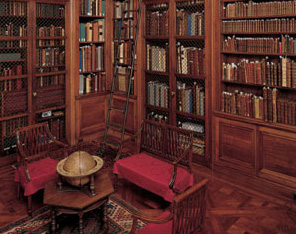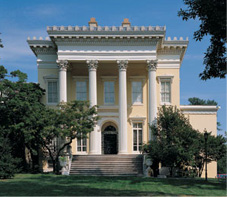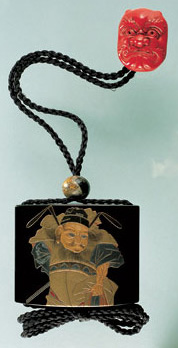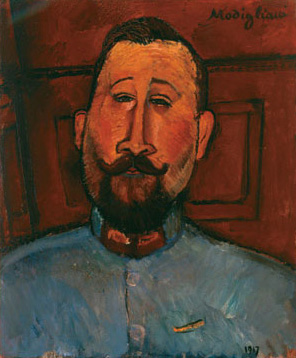 |
 |
|
 |
|
|
|
The John Work Garrett Library, Evergreen House. Courtesy of Evergreen House, Johns Hopkins University, Baltimore; photography by Doug Hansen. |
Built in 1858 as a grand Italianate residence by the Broadbent family of Baltimore, Evergreen House was purchased twenty years later by Baltimore & Ohio Railroad president John Work Garrett for his son, T. Harrison Garrett (1849–1888), and daughter-in-law, Alice Whitridge Garrett (1851–1920). Commanding a rise of land along Charles Street in the city’s fashionable present-day Guilford neighborhood, this colossally-scaled mansion was home to two generations of Garretts, who expanded and filled its rooms with major collections of fine and decorative arts, rare books, and manuscripts (Fig. 1). Occupied by the family from 1878 to 1952, Evergreen House is today a fine arts museum and cultural center owned and operated by Johns Hopkins University, showcasing the patronage traditions and collecting passions of a leading Maryland family.
|
 |
|
|
|
| Fig. 1: Façade of Evergreen House. Courtesy of Evergreen House, Johns Hopkins University, Baltimore; photography by James van Rensselaer. |
|
T. Harrison Garrett and his wife, Alice, undertook a series of major renovations and additions to the house beginning in the mid-1880s. The largest was the creation of a porte cochère and north wing built for their three sons—John Work (1878–1942), Horatio Whitridge (1873–1896), and Robert (1875–1961)—containing a bowling alley, billiard room, gymnasium, and school room. At this time, the first of what would eventually become four libraries in the house was installed in the main hall of the second floor.
Both father and eldest son assembled an exceptional collection of Asian art (Fig. 2): bronzes, inro, netsuke, porcelains, and tsuba were acquired at New York galleries by T. Harrison, and subsequently in the late 1890s by John while traveling in Japan with a Johns Hopkins University medical commission. T. Harrison’s broad collecting interests also included rare books, coins, prints, manuscripts, and autographs.
|
|
 |
|
|
|
Shoki and oni. Two-case inro of wide form, bearing a roiro ground, Edo Period, 18th century. H. 63, W. 78 mm. Listed in T. Harrison Garrett’s 1887 catalogue, Number 55. Netsuke in the form of an oni mask, signed Joko, late 19th century. Red lacquer. H. 40, W. 32 mm. Courtesy of Evergreen House, Johns Hopkins University, Baltimore; photography by David Enders Tripp. |
John Work Garrett’s cultural tastes were inspired by his father’s and expanded by his years of diplomatic service in Europe and South America for five U.S. presidents. While he added to his collections of coins and rare books, his wife, Alice Warder Garrett (1877–1952), concentrated on building a collection of modern art. Inheriting Evergreen upon the death of his mother, John returned to Baltimore in 1921 with Alice and they immediately commenced the second major phase of architectural transformations of the estate.
One of the most notable alterations was the incorporation of a remarkable private theatre created in 1922–1923 (see pages 154–155). Other changes to the house were made to encompass the couple’s extensive and growing collections. They included a fire-resistant walnut paneled library designed by Baltimore architect Laurence Hall Fowler in 1928 (Fig. 3). Alterations to the former bowling alley and billiard room in the 1930s created gallery spaces for the Japanese lacquer and Chinese porcelain collections. In 1941 a new library extension was added, and Alice worked with Fowler to redesign the formal first floor drawing room to create exhibition space for her exceptional collection of twentieth-century European paintings. Represented in the picture collection and on view today are works by Picasso, Degas, Modigliani (Fig. 4), Dufy, Vuillard, Bonnard, Utrillo, and Zuloaga, along with a major Tiffany glass collection that came to the university by an external bequest in the 1940s.
Appointed a trustee of Johns Hopkins University in 1937, upon his death in 1942, John bequeathed Evergreen and his collections to the school. His will stipulated that the house “always be hospitably open to lovers of music, art, and beautiful things, and to qualified and competent students and investigators who could make use of its collections.…” |
 |
|
|
|
Amedeo Modigliani (Italian, 1884–1920), Dr. Devaraigne—Le Beau Major, 1917. Oil on canvas, 56 x 48.3 cm. Courtesy of Evergreen House Foundation; photography by David Tripp.
|
|
Appointed a trustee of Johns Hopkins University in 1937, upon his death in1942, John bequeathed Alice extended the bequest at her passing in 1952 with the creation of the Evergreen House Foundation, whose mission, in partnership with the university, is to preserve the house, and its collections and landscape, while
sustaining the Garretts’ legacy of patronage of artists, musicians, and students. Programming today actively seeks to honor and extend the family’s commitment to Evergreen’s prominent role in the cultural life of the city of Baltimore.
In addition to its schedule of guided house tours, Evergreen has become a venue for changing art exhibitions that draw inspiration from the Garretts’ collections. Opening in May 2004 is Sculpture at Evergreen, a biennial series of juried outdoor exhibitions in which ten artists are invited to respond to the house, its heritage, and site. The Evergreen Concert Series, begun in 1952, continues the Garretts’ patronage of chamber musicians brought to the house to perform. Each June the Baltimore Shakespeare Festival opens its summer season with a week of outdoor performances in a creek-side meadow set amidst the estate’s twenty-six acres. There are also lectures, book signings, and an annual Carriage House Holiday Sale featuring the wares of over twenty Mid-Atlantic museum shops. Evergreen’s carriage house and north wing are popular sites for meetings and special occasion rentals. |
|
|
|
Evergreen House is open twelve months a year, Monday through Friday from 10 a.m. to 4 p.m. and Saturday and Sunday from 1 p.m. to 4 p.m. For more information call 410.516.0341 or visit www.jhu.edu/historichouses.
Robert Saarnio is Director of Historic Houses and Curator of University Collections at Johns Hopkins University. |
|
|
|